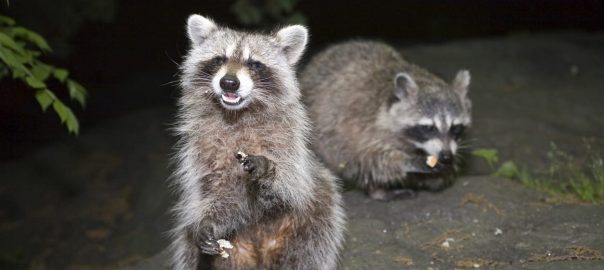How to Remove Raccoons from an Attic

Raccoons typically nest in attics in Toronto during the breeding season around spring. The coons are simply looking for somewhere safe and warm to raise babies but this is no reason to share your home with wildlife. These animals carry diseases; they damage your insulation and wiring and can be vicious which puts you, your children and pets at constant risk of attack.
Signs of raccoon activity in the attic include unusual noises especially at night, nesting material such as torn insulation and clothing and damaged drywall, roofing tiles and wooden support beams.
Removing Raccoons from the Attic
Although many so-called experts to recommend trapping the raccoons, keep in mind that it is illegal to transport wildlife in Toronto for more than a kilometre without a permit. Traps also expose you and the animal to injury especially if you have no experience handling wildlife. If trapping is the only option, it is best to leave the job to a licensed raccoon removal company.
Exclusion is the most humane and effective methods for getting rid of raccoons in the attic and experts prefer to use this method whenever possible.
Begin by inspecting for entry points and sealing them with galvanized steel mesh or metal flashing. Leave only the main entrance open. The main entrance is the one with the most evidence of raccoon activity such as food remnants, nesting debris, tracks or animal feces and urine.
Next, install a one-way door at the main raccoon entry-point. The spring loaded door only opens outward to let the animals through and locks them out permanently. Inspect the attic regularly until you are sure that all the raccoons have left before removing the one-way door and sealing the remaining hole with metal flashing or galvanized steel mesh.
Hire a Raccoon Removal Company
Evicting raccoons is simple but simple cannot be confused for easy. Successful exclusion is often complicated even for seasoned raccoon removal experts.
Remember that raccoons nest in the attic primarily to breed. Installing the one-way door before the babies are old enough to follow their mother through the door is a major concern. Sealing the baby raccoons inside the nest means they die of starvation and dehydration. You need to inspect the nest for a litter and most likely remove it by hand.
There is also the issue of cleaning, disinfecting and repairs after successful eviction. Raccoon feces and urine carry diseases and contain pheromones that may attract other wildlife. You most likely have to repair or replace insulation, exposed wires and structural damage. Lastly, you need to seal the attic and the rest of the house to keep wildlife out permanently.
All these jobs require an expert’s keen eye, training, experience and special equipment. Hire a raccoon removal company in Toronto that offers a warranty of at least two years to guarantee a successful outcome.